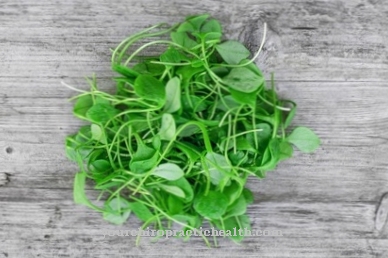The nutrient-rich Tepary bean comes from Arizona and northern Mexico, where it has been known since the third millennium BC. We use the nutrient-rich legume as a basis for soups and as vegetables.
What you should know about the tepary bean

The tepary bean (Phaseolus acutifolius) is one of the legumes. Since it is a drought-resistant plant, it is now mainly cultivated in the rain-poor regions of Africa. There it serves as food and feed as well as protection against erosion.
The plants reach heights of around 30 centimeters and grow up to two meters long climbing shoots. On the inflorescences there are up to five white to light purple single flowers, from which after self-fertilization ten centimeter long pods with five to seven seeds, the actual beans, emerge. When exposed to strong sunlight, the flowers close and only open again towards evening. The beans are usually sown at the beginning of the rainy season so that the fast-growing germs benefit from the wetness. Some growers do not sow until the end of the wet season because the soil then has a sufficient amount of moisture.
After germination, the tepary bean hardly needs any water, although it yields significantly more yield with artificial irrigation. In this case the harvest yields up to 20 quintals per hectare, in very dry regions it is only five. Farmers harvest the green pods most of the year, starting as soon as the first are the required size. Depending on the variety, the beans themselves are white, pink, brown or dark purple, sometimes with speckles. The white types taste sweet and are used in corresponding dishes. The darker the color of the beans, the more the sweetness is lost and gives way to an earthy taste. The spices known in Central America and Africa can always be used to create appealing dishes.
Many see the future of the tepary bean more as a feed and straw supplier than as a human food. But thanks to the high-quality ingredients and the satiety factor, it has great opportunities to establish itself on the human diet.Especially in economically weak countries, the legume is an important food because of its undemanding nature.
Importance to health
The tepary bean is not only very nutritious but also healthy. The residents in the original growing areas have already proven this. The Indians had great endurance and physical stamina.
They lived mainly on what the soil offered them: vegetables, also beans, fruits and now and then buffalo meat. The high proportion of carbohydrates in the tepary beans saturates quickly and sustainably, while the abundant proteins serve to build muscle. In addition, protein is an important source of energy overall. Although many of us avoid bean dishes because of their flatulence, they should use them every now and then for the sake of the valuable ingredients. However, it is important to drink enough when consuming, as legumes in general and tepary beans in particular contain little water.
The low fat content of the bean is almost always an advantage. Nevertheless, this type of bean is not suitable for weight loss because it is high in calories. The beans not only serve the health of humans, but also that of the soil. They are able to fix nitrogen there, which promotes fertility and allows farmers to forego additional (artificial) fertilizers. The naturalness of the field crops serves human health again.
Ingredients & nutritional values
The calorie content of the tepary bean of 380 per 100 grams of the seeds is quite high and thus discourages many figure-conscious people from eating it. But it contains a lot of protein: The raw protein content is 25 percent. The low fat content of just one and a half percent is also pleasant.
As with all legumes, there are many carbohydrates for this; for the tepary bean it is around 65 percent. Of this, however, between three and five percent is raw fibers, which are good for the intestines. The high content of minerals with three to five percent and quite a lot of vitamins are extremely good for beans.
Intolerances & allergies
Like most legumes, tepary beans have a flatulence effect. Therefore, people with a sensitive digestive tract should avoid it. Added to this is the content of toxic lectins, which are found in all legumes.
Lectins are proteins that combine with certain carbohydrates and can be deposited on the wall of the small intestine. In the worst case, it becomes porous and the toxins enter the bloodstream. Since lectins largely die off at temperatures above 75 degrees Celsius, there is no great risk with cooked beans. Very sensitive patients or those with an attacked intestinal wall should, however, avoid tepary beans.
Shopping & kitchen tips
With us the tepary beans are almost exclusively available dried or boiled down in cans; the fresh legumes are not to be found in Central Europe in the trade. The interested party can obtain the seeds from abroad and at least let them germinate.
They do well in a greenhouse with the dry and very warm climatic conditions of the countries of origin. If you have fresh tepary beans available, you can also eat the pods: They should still be green and, unlike those of sweet peas, have to be cooked beforehand. Then they make a tasty vegetable. In the case of canned fruits, there is no watering that is essential for the dried beans. This is best done overnight in a pot of water that must cover the beans completely and a few centimeters beyond.
Then the tepary beans are boiled in fresh water or vegetable broth and then processed into soup or vegetables. The canned goods can be kept for almost any length of time; the dried beans should be stored in a cool, dry place in a well-closed container so that they are suitable for consumption for several months.
Preparation tips
Although tepary beans are little known to us, for many they represent a healthy and interesting alternative to other legumes. This is mainly due to the different flavors of the individual seeds. All are suitable for processing as soup, vegetables or (cooked) salad. A tepary bean puree is less well known.
It's made in a similar way to potatoes, but with a completely different taste. From white seeds it goes in a sweet direction and therefore tastes very good with game or poultry. With fresh fruit it is even a fancy dessert. The dark seeds are very suitable for a chili con carne. The slightly earthy taste gives the dish a special note.
















.jpg)











.jpg)